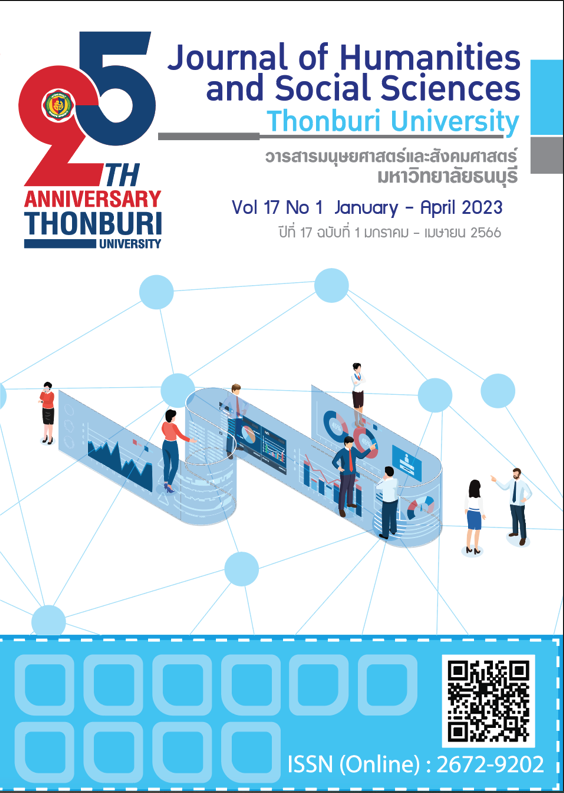Development of the Hybrid Learning Model with Design Thinking Process to Develop the Creativity
Keywords:
Hybrid Learning, Design Thinking Process, Creativity, Instructional ModelAbstract
This research aims to develop the Hybrid Learning model with a design thinking process,
to develop the creativity of Mathayomsuksa 6 students The sample group used in the research is a Mathayomsuksa 6 student, Mangkon Kamalawat Wittayalai School, under the Phrapariyattidhamma Educational Service Area Office, General Education Department District 13, 16 Novices, obtained by simple random sampling, the research tool was the 5 Ons a Hybrid teaching and learning model with a design thinking process. The tools used for data collection were the Creativity Assessment Form. The statistics used were Mean, and Standard Deviation. The results showed that Students studying using a hybrid teaching model be creative at a high level (x.= 4.04, S.D. = 0.47) according to the established research hypothesis. The Hybrid Learning model with a design thinking process consists of 5 steps as follows: (1) Empathize (2) Define (3) Ideate (4) Prototype (5) Test. There are two main components of hybrid teaching and five sub-sections: (1) Face to Face learning consists of On-Site and On-Site (2) Distant online Learning consists of On-Air, On-Line, and On-demand
References
ก่อเกียรติ ขวัญสกุล. (2564). การบูรณาการจัดการเรียนรู้ด้วยกระบวนการคิดเชิงออกแบบเพื่อพัฒนานวัตกรรมสื่อ โครงการชุมชนท่องเที่ยวโอท็อปนวัตวิถี บ้านวังยาว ตำบลเกิ้ง อำเภอเมือง จังหวัดมหาสารคาม. วารสารศึกษาศาสตร์ มหาวิทยาลัยสงขลานครินทร์ วิทยาเขตปัตตานี, 32(1), 164-184.
คณะกรรมการการศึกษาขั้นพื้นฐาน. (2564). แนวทางการจัดการเรียนการสอนในสถานการณ์การแพร่ระบาดของโรคติดเชื้อไวรัสโคโรนา 2019 (COVID 19) ภาคเรียนที่ 1 ปีการศึกษา 2564. สืบค้นเมื่อ 5 พฤษภาคม 2565, จาก http://school.ska2.go.th/banbuengphichai/data/knowledge/25641126_132909_5369.pdf
ชนิกานต์ กลิ่นอาจ. (2563). วิจัยปฏิบัติการพัฒนาความสามารถในการสร้างสรรค์และนวัตกรรมของนักเรียนชั้นมัธยมศึกษาปีที่ 5 ด้วยการจัดการเรียนรู้ตามกระบวนการคิดเชิงออกแบบ เรื่อง เคมีไฟฟ้า. การค้นคว้าอิสระ กศม. สาขาวิชาวิทยาศาสตร์ศึกษา, มหาวิทยาลัยนเรศวร.
ปณิตา วรรณพิรุณ. (2554). การเรียนแบบผสมผสานจากแนวคิดสู่การปฏิบัติ. วารสารการอาชีวะ และเทคนิคศึกษา, 1(2), 43-49.
ปิยธันว์ เบญจเทพรัศมี. (2560). การพัฒนาหลักสูตรเสริมสมรรถภาพการจัดการเรียนรู้แบบผสมผสานสำหรับครูคอมพิวเตอร์ เพื่อส่งเสริมการรู้เทคโนโลยีสารสนเทศและการสื่อสารของนักเรียนระดับประถมศึกษา. วิทยานิพนธ์ กศ.ด. สาขาวิชาหลักสูตรและการสอน, มหาวิทยาลัยนเรศวร.
Altay, I., & Altay, A. (2019). A Review of Studies on Blended Learning in EFL Environment. International Journal of Curriculum and Instruction, 11(1), 125–140. Retrieved May 5, 2022, from www.ijci.wcci-international.org
Ambrajei, Anton N., Golovin, Nikita M., Valyukhova, Anna V., Rybakova, Natalia A., Zorin, & Victor Yu. (2021). Use of hybrid learning model for SAP-related technology education. ICID-2019 Conference.
Behzad, M., Rasheed, N., Malik, A., & Merchant, S. (2022). Technology-Embedded Hybrid Learning. Preprints, pp. 1-12.
Cserhati. (2019). The Power of Innovation and Design Thinking in Implementing the 2030 Agenda for Sustainable Development.Retrieved November 20, 2022, from www.unssc.org/news-and-insights/blog/power-innovation-and-design-thinking-implementing-2030-agenda-sustainable
De Bono, & Edward. (1982). Lateral Thinking: A Text book of Creativity. Harondswort. Penquin Book. Torrence, E. P. (1992). A National Climate for Creativity and invention. Gifted Child Today. 5(1), 10-14.
Guilford, J.P. (1950). Creativity. American Psychologist, 5, 444-454.
Idrizi, E., Filiposka, S., & Trajkovik, V. (2022). Hybrid Learning - the new normal. In Green Economy and Technological Change for Sustainability-5th international Scientific Conference on Business and Information Technologies. South East European University Tetovo of North Macedonia.
Khoiriyah, A., & Husamah. (2018). Problem-based learning: creative thinking skills, problem-solving skills, and learning outcomeof seventh grade students. Jurnal pendidikan biologi Indonesia, 4(2), 151-160.
Lestari, S. Syafril, Sri Latifah, E. Engkizar, D. Damri, Zainal Asril, & Nova Erlina Yaumas. (2021). Hybrid learning on problem-solving abiities in physics learning: A literature review. Young Scholar Symposium on Science Education and Environment of Journal of Physics: Conference Series 2021, pp. 1-12.
Muchsini, B., & Siswandari. (2020). Hybrid Learning Design to Minimize Academic Stress of Digital Natives’ Generation in Accounting Course. Journal of Educational Science and Technology, 6(1), 1-8.
Siburian, J, ibrohim, A, & Saptasari, M. (2019). The Correlation Between Critical and Creative Thinking Skills on Cognitive Learning Results. Eurasian Journal of Educational Research, (81), 99-114.
Sumarni, W., & Kadarwati, S. (2020). Ethno-stem project-based learning: its impact to critical and creative thinking skills. Jurnal Pendidikan IPA Indonesia, 9(1), 11-21.
Supachaisamanpun J. (2019). A study of design thinking for improving employee performance in bangkok specialty coffee shops, thesis for the degree of master. Thammasat university.
The D School Teaching Team. (2008). Design thinking bootcamp. Retrieved June 19, 2022, from www.creativecommons.org/licenses/by-nc-sa/3.0/
Widyartono, D. (2021). Academic Writing Learning Model in Higher Education Based on Hybrid Learning. Journal of Physics: Conference Series 2021, pp. 1-7.
Zubaidah, S., Miftahul fuad, N., Mahanal, S., & Suarsini, E. (2017). Improving Creative Thinking Skills of Students through Differentiated ScienceInquiry Integrated with Mind Map. Journal of Turkish Science Education, 14(4), 77-91.
Translated Thai References
Benjateprassamee P. (2016). A development of hybrid learning management competency curriculum for computer teacher to enhance information and communication technology literacy of elementary students. Thesis Ph.D. in Curriculum and Instruction, Naresuan University. (in Thai)
Klinart, C. (2019). An action research on developing 11th grade students' creative ability and innovation using design thinking process the topic of electrochemistry. Independent Study, M.Ed. in Science Education, Naresuan University. (in Thai)
Kwunsakul, K. (2021). The Integration of Instruction with Design Thinking Process to Develop Media innovation, O-Top Tourism Community Project, Ban Wang Yao, Keng Subdistrict, Muang District, Maha Sarakham Province. Journal of Education, Prince of Songkla University, Pattani Campus, (32)1, 164-184. (in Thai)
Office of the Basic Education Commission. (2021). Guidelines for teaching and learning in the situation of coronavirus 2019 (COVID 19) semester 1 academic year 2021. Retrieved May 5, 2021, from http://school.ska2.go.th/banbuengphichai/data/knowledge/25641126_132909_5369.pdf (in Thai)
Wannapiroon, P. (2011). Blended Learning: Principles into Practice. Journal of Vocational and Technical Education, 1(2), 43-49. (in Thai)
Downloads
Published
How to Cite
Issue
Section
License
Copyright (c) 2022 kiattisak sisamud

This work is licensed under a Creative Commons Attribution-NonCommercial-NoDerivatives 4.0 International License.
ผลงานที่ปรากฎในวารสารฉบับนี้เป็นลิขสิทธิ์เฉพาะส่วนบุคคลของผู้เขียนซึ่งต้องรับผิดชอบต่อผลทาง กฎหมายที่อาจเกิดขึ้นได้และไม่มีผลต่อกองบรรณาธิการ






